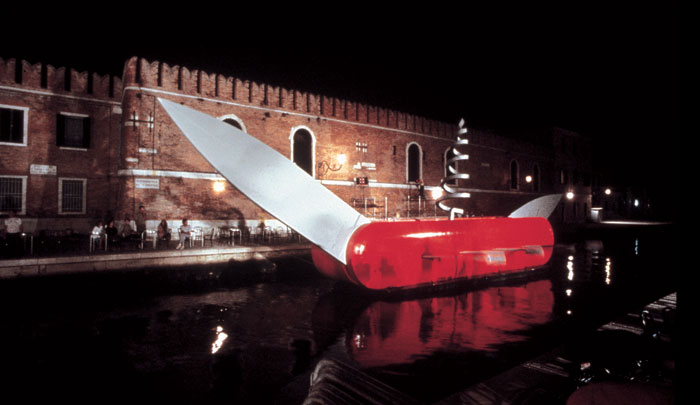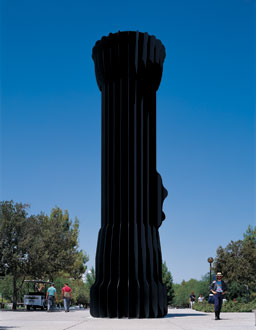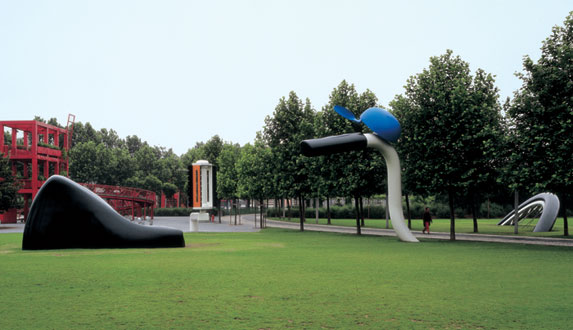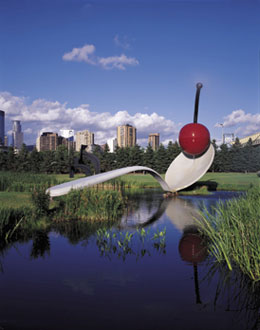Art is something that makes our life more beautiful, fascinating, and pleasant. Captivating paintings, magnificent sculptures, and amazing graphics – this all is about art. We enjoy it, we love it, and we try to find some kind of support in such works. Sculpture is one of the artworks, which are created with the help of some hard material, stones, glass, texts, sounds, lights, or wood separately or together.
One of the brightest representatives of this type of art are Claes Oldenburg and his wife, Coosje van Bruggen. They are known for their Shuttlecock/Blueberry Pies I and II (detail), Spoonbridge and Cherry, Balancing Tools, and Knife Ship (Image 1). The collaboration between Oldenburg and Bruggen has brought so many interesting details in this art and made their works known to millions of people.
Claes Oldenburg was born in Stockholm, Sweden, in 1929. He attended the courses of Art in Chicago and, in 1956, he moved to New York to create his sculpture and present them to the world. In 1972, he opened the Mouse Museum where he demonstrated his projects and documents.
In 1976, he met Coosje Van Bruggen, an art historian and a wonderful artist, who was known by her colourful sculptures. “Claes Oldenburg has always carried a pocket notebook filled with sketches and ideas. His wife, Coosje van Bruggen, developed the same habit.” (Sarnoff 2002) This couple met in Amsterdam. Bruggen was an assistant curator at the retrospective exhibition of Oldenburg’s work.
In 2009, Coosje van Bruggen died because of metastatic breast cancer at the age of 66. During their collaboration, they created more than 40 public sculptures. Their works were not only for different museums. They created sculptures for numerous parks and urban centres. Each of their creations represents huge objects in comparison to their surroundings. Flashlight, created in 1981 (Image 2) or a magnificent upended sculpture, and Buried Bicycle, created in 1990 (Image 3) and presented in Paris.
At first, many professionals criticized the collaboration between Mr. Oldenburg and Ms. Bruggen. Sometimes, she got refuses for crediting, and Oldenburg had nothing to do but support his wife and proved that their works were worthy of attention. It was a true collaboration.
Oldenburg created drawings and Bruggen chose the colours. They called their works and collaboration “a unity of opposites.” (Oldenburg, et al. 2007) However, with time, their creations became to be in great requisition. Their works may be found in different parts of the whole world: New York, Philadelphia, Nebraska, several cities in France, England, Italy, Japan, Germany, and many other countries.
Of course, sculptures were not the only products of their collaboration. Oldenburg wanted to leave something for the next generation, so, he created annotations to the work. Bruggen suggested the idea of small scale in order to present “books of drawings to be reasonable enough in price for students to acquire.” (Axsom et al. 1997)
Both of these two sculptors had their own opinions concerning their collaboration. Oldenburg said that their work reflect the surroundings and the context through their own imagination. Such approach makes their works both public and personal. (Oldenburg & Bruggen 2006)
In her turn, Bruggen admitted that such collaboration underlined their complete understanding of something impossible, a unity of rather different dynamics, a combination of speed and stillness. This is what they worked with for a long period of time. (Oldenburg & Bruggen 2006)
It is necessary to admit that people cannot get the essence of this or that sculpture. They think that it is one more work that shows the results of someone’s crazy imagination. The sculptures by Oldenburg and Bruggen are famous due to their large scales and unique combinations of colours. Usually, the sculptures are created to help people: carry things, hold water, or tell stories. Let us examine several sculptures created by Oldenburg and Bruggen.
After they created several magnificent works, they were ask to present a sculpture of fountain in Minneapolis Sculpture Garden. It is the place, where one of their best works are now, Spoonbridge and Cherry. The spoon has already appeared in several previous works by Oldenburg.
Now, it was a really huge spoon (in the form of the bridge through a little pond) with a cherry on its top. This cherry was a kind of additional reference to underline the fact that it was a garden with its tasty fruits. Taking into account the climate of Minnesota, in winters, this sculpture glanced with snow, and in summer, it gleams when water flows through the cherry’s surface (Image 4).
“A huge spoon with cherry squirting water has become the unofficial symbol of Minnesota. Any tour of the town must pass Claes Oldenburg and Coosje van Bruggen’s Spoonbridge and Cherry for photo op with the skyline jutting up in the background.” (Dregni 2001)
Such recognition makes this work one of the loveliest places of this town. People from Minnesota are proud of having such a marvellous creation to share with tourists.
After Mr. Oldenburg and Ms. Bruggen visited northeastern England in order to vivify this region after the economical crisis, they decided to create something inappropriate in honour of Captain Cook (an explorer who was born in that region). They analyzed literature heritage of this country, and came to the conclusion that it should remind about unbelievable adventures of Gulliver and Poe’s story MS. Found in a Bottle.
This is the way of how Bottle of Notes appeared. “Bottle of Notes consists of a leaning, openwork painted steel bottle, an inner layer in blue composed of van Bruggen’s jottings, and an outer in white of extracts from Cooks’ log.” (Cartiere & Willis 2008) This sculpture is about 35 feet. It is tilted like the famous Tower of Pisa. So, the inhabitants of Middlesbrough got a remarkable sight to demonstrate for the visitors and enjoy it day by day.
In general, “the artists invited to contribute to the public spaces have clearly not been exhorted to think small.” (McNeill 1999) Claes Oldenburg and Coosje van Bruggen were known as perfect collaborators, who complete each other. Oldenburg’s passion to huge scales and Bruggen’s criticism helped to create wonderful works and please the viewer. In each part of the world, their creation has its own history and grounds.
These sculptors did not start creating something without a thorough investigation of the area, the region, and its history. Such deep analysis also helped to make a sculpture closer to people and make it as a part of their lives. Because of these simple but rather considerable reasons, the works of Oldenburg and Bruggen are appreciated by lots of people both inhabitants and tourists.
Reference List
Axsom, R. H., Platzker, D. and Oldenburg, C. 1997, Printed Stuff: Prints, Posters, and Ephemera by Claes Oldenburg: a Catalogue Raisonné 1958-1996. Hudson Hills.
Cartiere, C. and Willis, S. 2008, The Practice of Public Art. Routledge.
Dregni, E. 2001, Minnesota Marvels: Roadside Attractions in the Land of Lakes. U of Minnesota Press, Minnesota.
McNeill, D. 1999, Urban Change and the European Left: Tales from the New Barcelona. Routledge.
Oldenburg, C. and Bruggen, C. 2006, Claes Oldenburg and Coosje van Bruggen. Web.
Oldenburg, C., Bruggen, C., Gianelli, I., Rivoli, C., and Beccaria, M. 2007, Claes Oldenburg Coosje van Bruggen: Sculpture by the Way. Skira.
Sarnoff, I. 2002, Intimate Creativity: Partners in Love and Art. Univ of Wisconsin Press, Wisconsin.
Chronology of Large-Scale Projects by Claes Oldenburg and Coosje van Bruggen. Web.
About the works of Mr. Oldenburg and Ms. Bruggen. Web.
Exhibitions of Oldenburg and Bruggen
Images
Image 1

Image 2

Image 3

Image 4
